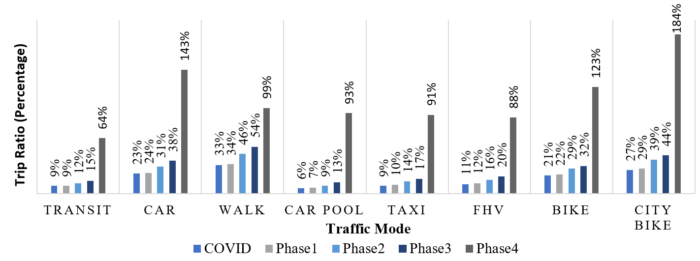Using multi-agent simulation to understand impacts of COVID-19 and mobility in post-pandemic economic reopening
MATSim-NYC
A multi-agent simulation test bed for evaluating emerging transportation technologies and policies
C2SMART developed a multi-agent simulation test bed, dubbed MATSim-NYC, which is intended to be the first of a “Network of Living Labs” virtual test beds for evaluating emerging transportation technologies and policies. Unlike those primary transportation planning tools, MATSim-NYC and the rest of the Network of Living Labs is developed with the intent to be a quick-response benchmarking tool for different emerging technologies or policies. If a public agency wanted to test certain transit alignments, different congestion pricing schemes, service regions for different mobility options, this tool can provide some consistent assessment of its impact on the city. The key strengths of this tool is the combination of dynamic traffic and heterogeneous activity scheduling behavior of the population through a multi-agent simulation. This means that the tool can capture the trade-offs between traffic congestion by time of day with the route and departure time decisions of its varied travelers at a citywide level.
MATSim-NYC-COVID
A recalibrated simulation model designed for evaluating impacts of COVID-19 and policies for post-pandemic economic reopening
As part of the MATSim-NYC development, we calibrated a behavioral model (estimated as a tour-based nested logit model) for choosing different modes of transportation in NYC, which was encoded into the MATSim-NYC simulation as utility function parameters. Using the COVID mobility data, we recalibrated the behavior model to reflect the increased aversion to use shared use modes like public transit.
The work from home (WFH) population was identified using study data from Dingel and Neiman (2020) , and with New York State reopening phase plan, the synthetic population in MATSim-NYC was adjusted to fit the WFH proportions under COVID using random selections. The mode choice utility parameters were then adjusted to make the resulting non-WFH mobility patterns fit the observed data. The updated parameters imply that there would be greater preference to drive, walk, and bike, and less preference for transit, and to less extent, taxi, FHVs, and Citi Bike. We had two different population segments, which indicates same trends but different impacts on Manhattan and non-Manhattan travelers.
Validation of the model using transit station turnstile data shows for an 15% sample of station ridership data, there is only an average difference of 20% in the MATSim-NYC-COVID model in predicting station-level trips. These results are acceptable for citywide planning models in practice.
Pre COVID-19 |
COVID-19 |
|


